#kingdom of thrace
Explore tagged Tumblr posts
Text
Coin of the Day #14 (5/18/2024)
A little Thrace for Saturday…


Kingdom of Thrace
AE12 - 1.94g
Lysimachos 305-281 BC
Lysimacheia Mint
Obverse Head of Athena right, helmeted
Reverse ΒΑΣΙΛΕΩΣ ΛΥΣΙΜΑΧΟΥ
Lion head facing front
SNG Cop 1170, Mueller 12
#coin of the day#kingdom of thrace#thrace#Lysimachos#ancient greece#greek coins#coin#coins#numismatics#ancient coins
5 notes
·
View notes
Text
Guess what :]
#just talking recreationally#hetalia#Historical hetalia#Sort of#Hetalia ancients#Hetalia thrace#Aph thrace#Hws thrace#Odrysian kingdom#Aph#Hws#Thrace#The one multichapter fic I started is suffering I'm so sorry I wanna finish it but I would rather write anything else atm#Also#THE WORLD#<- my tag for my hetaverse stuff
6 notes
·
View notes
Photo
This golden funerary mask was part of the goods discovered in a grave in 2004, during archaeological excavations on the Svetitsata mound near the village of Kran in the Stara Zagora region. A noble Tracian man, aged about fourty, was buried in the grave. According to a local burial rite - usually associated with the Orphism - his body had been dismembered, the grave receiving only fragments from the skull and his legs.
The golden mask weighs 673 grams and images the face of an adult man, with clearly portrayed individual features. It was cast and additionally processed by forging and chiseling. The portrait is dated to the 5th century BC and, so far, the only mask of this kind from this period in Thrace and the Mediterranean area. It said it is the mask of the Odrysian King Teres.

Discovered during excavations on the Svetitsata mound (in the Stara Zagora region of Bulgaria), this gold funerary mask is of a middle-aged Thracian man. An incredibly rare artefact, the mask itself weighs 673 grams, and has been dated to about the 5th century BC. It seems to portray some individualized features, and some believe it to be the mask of the Odrysian King Teres.
Courtesy of & currently located at the National Archaeological Museum, Sofia. Photo taken by vintagedept.
#history#burials#masks#odyrsian kingdom#thrace#bulgaria#stara zagora province#svetitsata tumulus#teres i#orphism
858 notes
·
View notes
Text
Unseen 3rd Century BC Thracian Temple Discovered by Archaeologists beneath ‘Large Mound’ in Bulgaria’s Plovdiv
The well-preserved ruins of the 3rd century BC Ancient Thracian temple discovered beneath a burial mound in Bulgaria’s Plovdiv. Photo by PodTepeto An Ancient Thracian temple from the 3rd century BC, of a type that has never been seen before, has been unearthed by archaeologists in Bulgaria’s Plovdiv, underneath a massive man-made hill known as “the Large Mound” (“Golyamata Mogila”). The Large…
#Ancient Thrace#Ancient Thracians#Bessi#burial mound#burial mounds#church#excavations#Hellenic#Large Mound (Golyamata Mogila)#Middle Ages#mortar#Odrysian Kingdom#Odrysians#pagan temple#Philipopolis#Plovdiv#Plovdiv Municipality#Plovdiv Museum of Archaeology#Pulpudeva#quadrae#Sapaeans#temple#Thracian temple#Thracians
0 notes
Text

Tetradrachm - Ancient Greek Macedonian Kingdom, Thrace, King Lysimachus Reproduction Coin.
Obverse: diademed head of the deified Alexander right, with horn of Ammon. Reverse: Athena Nikephoros (goddess Athena of Victory) seated left, holding Nike, left arm resting on shield, transverse spear in background; Φ to outer left; to inner left, turreted head of goddess Tyche right (Smyrna mint). Diameter coin 28 mm.
#tetradrachm#coin#ancient#greek#greece#macedonian#kingdom#king#Lysimachus#Lysimachos#alexander the great#goddess athena#collectibles#coins#Thrace
0 notes
Text

Roman Marble Statue Found in Bulgaria
Archaeologists uncovered a fully preserved statue from the ancient city of Odessos. Archaeologists from Regional History Museum in Varna (Bulgaria's biggest maritime city) reported this afternoon, October 15, about this exceptional find during the excavations of the ancient city - a marble sculpture from the Roman era, slightly taller than a human height.
It depicts a middle-aged man with a short beard, dressed in a toga, with a scroll in his hand. On the front of the pedestal there is a well-preserved inscription, and from a preliminary reading it is clear the name of the person depicted: G(ai) Marius Hermogenes.
The only part that is missing is the wrist and there is some minor damage to the face, so restoration is needed before it can go on display, Archaeologia Bulgarica said on its Facebook page.
The statue was discovered during construction work in an area of sandy deposits, outside the walls of the ancient city. It was promptly reported to the museum by construction contractor Georgi Kraychev. The sculpture is believed to be from the end of the 2nd and the first half of the 3rd century.
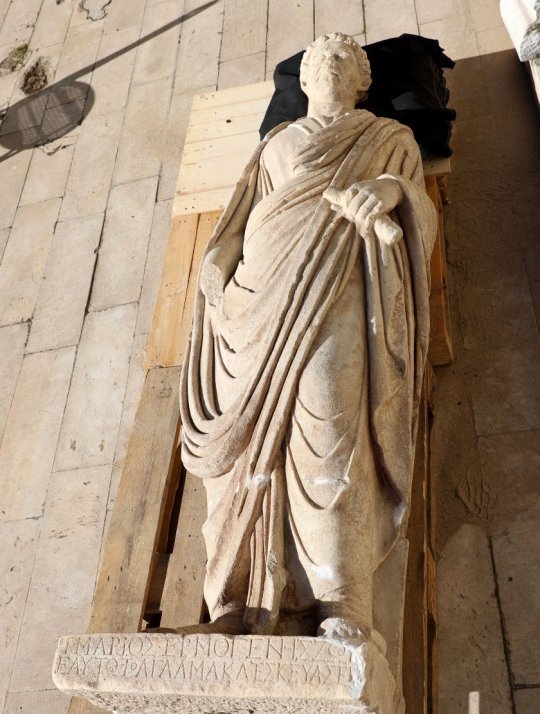

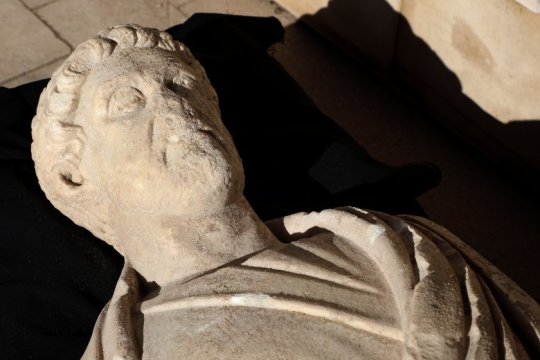
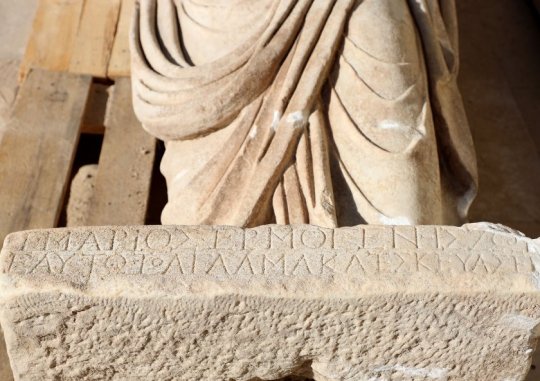
The present-day city of Varna, Northeastern Bulgaria, originated as a settlement named Odessos (Ὀδησσός) which was founded by Ionian colonists from Miletus around 600–550 BC. The Greeks established their colony on the site of an earlier Thracian settlement.
In 335 BC, Alexander the Great conquered almost the entirety of ancient Thrace, and Odessos became part of the Macedonian Kingdom.
Odessos flourished most significantlly during the Hellenistic Age (end of III – I BC), when the city served as a starting point of troops of the successor of Alexander the Great – king Lysimachus (323–280 BC) who proclaimed himself king of Thrace. Big public buildings like temples, theatre, gymnasium (school for boys) and others were built during this period. Due to the increase of Thracian population in the city, a temple of the Thracian god-rider Heros Carabazmos and a temple of Artemis Phosphoros were built in II – I BC.
In 15 AD, Odessos became part of the Roman Empire, in the province of Moesia (later Lower Moesia), and became its main port on the Black Sea (Pontus Euxinos). Huge and ornate warm baths (Roman baths), the fourth largest in Europe, were built 7000 square meters of land.
It was called Varna by the Ancient Bulgars after the First Bulgarian Empire conquered it in the late 7th century AD.
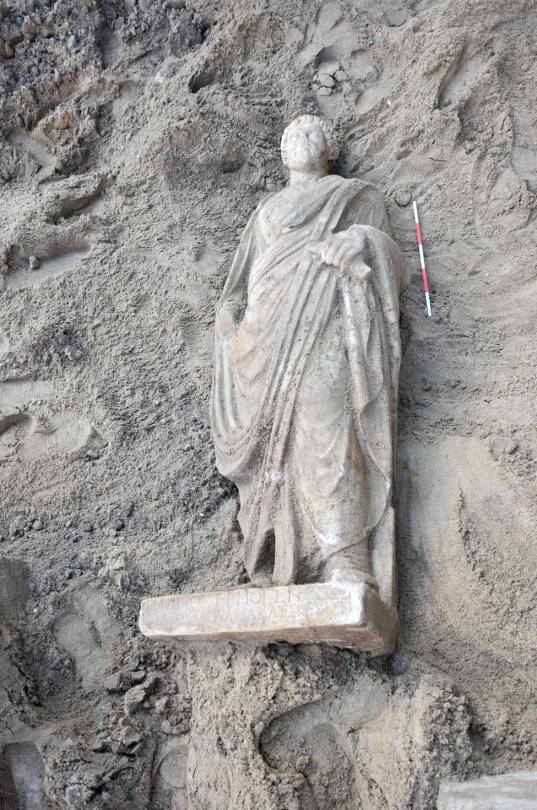
#Roman Marble Statue Found in Bulgaria#Varna Bulgaria#ancient city of Odessos#G(ai) Marius Hermogenes#marble#marble statue#marble sculpture#ancient artifacts#archeology#archeolgst#history#history news#ancient history#ancient culture#ancient civilizations#roman history#roman empire#roman art#ancient art#art history
58 notes
·
View notes
Photo
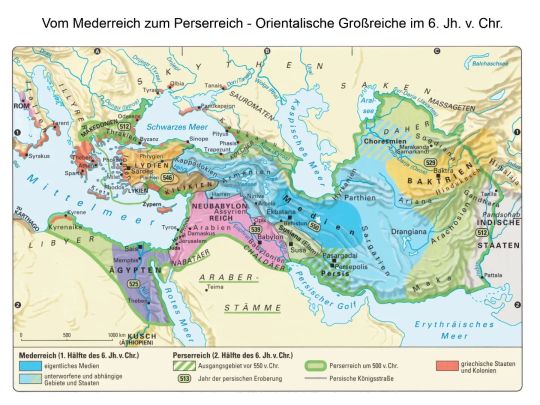
West Asian empires in the 6th century BC
“TaschenAtlas – Weltgeschichte”, Klett-Perthes Verlag, 2004
via cartesdhistoire
According to Herodotus ("Histories", Book I), Deioces became king of the Medes in 701 BCE in western Iran. He united the six Median tribes and repelled Assyria's influence from his capital, Ecbatana. His grandson Cyaxares destroyed the Assyrian Empire with the help of the Babylonians (612 BCE), and then they divided its remnants. Cyaxares also destroyed the kingdoms of the Mannaeans and Urartu and advanced into Asia Minor, where the Halys River became the border with Lydia (585 BCE). His son Astyages succumbed to the Persians in 550 BCE, and Media became a satrapy.
In western Media, Nabopolassar founded the Chaldean dynasty ruling over the Neo-Babylonian Empire (625-539 BCE). His son Nebuchadnezzar II (605-562 BCE) restored Babylonian greatness and built the Temple of Marduk (the biblical Tower of Babel) in his capital, as well as the fortifications known as the "Median Wall," palaces, and the Hanging Gardens (on terraces). In 539 BCE, the Persians seized Babylon.
Achaemenid Persian Cyrus II conquered the Median Empire, Lydia (546 BCE), Babylon (539 BCE), and the Greek cities of western Asia Minor, Bactria, and Sogdia (529 BCE). His son Cambyses II subjugated Egypt and the Greek cities of Cyrenaica (525 BCE). The Persians then adopted the Assyrian concept of an empire uniting all the peoples of the world under one great king ("King of Kings"). Darius I conquered the Indus Valley in 512 BCE and occupied Thrace and Macedonia (513 BCE).
The Assyrians and Chaldeans had already begun to politically and civilly unify much of the Middle East, and the Persians continued this tradition. Thus, Aramaic, already used as a language of communication, was adopted as the language of Persian administration.
Despite its power, the history of the Achaemenids is poorly known because the scribes used parchment or papyrus; apart from rare royal inscriptions, there are few accounts from reluctant subjects or passionate opponents.
77 notes
·
View notes
Text
Zagreus Sabazius
Important reminder. Everything I write about here is only indirectly connected by distant assumptions and rare crossings and absolutely should not be considered the immutable truth. As someone whose patron is Zagreus, I write about my findings and assumptions, but I am also totally possibly to be mistaken and see what I want to see myself. Take everything with a grain of salt.
We have already once looked at the Greek sources with the story of Zagreus. But beyond the rare surviving Greek sources, we will always have something else. Why is Zagreus sometimes mentioned with the epithet “Sabazius”? What does this epithet mean? What are Zagreus' powers? And why, after all, is he and Gaia called “highest of the all gods” in the Alcmeonis?
Welcome to my deep dive on one of the most mysterious theoi — Zagreus Sabazius.

So, later Greek writers, like Strabo in the first century CE, linked Sabazios with Zagreus. But who is Sabazios and what does it mean?
Sabazius comes from a common root with Sanskrit sabhâdj, honored, and with Greek σέβειν, to honor. It's also may be connected with the Indo-European *swo-, meaning "[his] own," and with the idea of freedom.
Sabazios is a deity originating in Asia Minor. He is the chief sky god of the Phrygians and Thracians. Sabazios gained prominence across the Roman Empire, particularly favored in the Central Balkans due to Thracian influence. On some monuments Sabazius is called “master of the cosmos”.

Decree of the organisation of worshippers of Sabazius, 102 BC
It seems likely that the migrating Phrygians brought Sabazios with them when they settled in Anatolia in the early first millennium BCE, and that the god's origins are to be looked for in Macedonia and Thrace. The ancient sanctuary of Perperikon in modern-day Bulgaria, uncovered in 2000, is believed to be that of Sabazios.


Two altars in the sanctuary were used for blood sacrifice.

And as Euripides has already graciously told us, Zagreus was honored as a god of blood, among other things. Sabazius, as a deity, was often associated with sky, thunder, nature, boons, mystery, and blood. One of its most frequent symbols was serpent.
Sabazius' references sometimes included Cybele. She is an Anatolian mother goddess. She is Phrygia's only known goddess, and was probably its national deity. Greek colonists in Asia Minor adopted and adapted her Phrygian cult and spread it to mainland Greece and to the more distant western Greek colonies around the 6th century BC.
In Greece, Cybele met with a mixed reception. She became partially assimilated to aspects of the Earth-goddess Gaia, of her possibly Minoan equivalent Rhea, and of the harvest–mother goddess Demeter.
And now everything suddenly made sense. Why are Gaia and Zagreus named the highest of all the gods in Alcmeonis? Because they always have been.

In her transition to Greece, Cybele, Phrygia's only known goddess, was named Gaia (which honestly makes much more sense to me than associating her with Rhea or Demeter). And Zagreus? And Zagreus remained Zagreus.
Gaia Cybele and Zagreus Sabazius, Mother Earth and Sky King, the highest gods of the Phrygians and Thracians, who later also made their way to Greece.
But unfortunately, no individual direct myths about King Sabazius have survived either.
But there was also one thing that persisted and always baffled me.
In my personal experience with Zagreus, his signature weapon has always been moonblades to me. And I always wondered why. What does Zagreus have to do with the moon? Why is it always an integral part of his power and history in my experience?
Well, now I know the answer.
At one point Sabazius merged with the Asia Minor and Syrian moon deity, Mēn. Mēn was a lunar god worshipped in the western interior parts of Anatolia. He is attested in various localized variants, such as Mēn Askaenos in Antioch in Pisidia, or Mēn Pharnakou at Ameria in Pontus.

Bust of Mēn in Museum of Anatolian Civilizations
In the Kingdom of Pontus, there was a temple estate dedicated to Mēn Pharnakou and Selene at Ameria, near Cabira (Strabo 12.3.31). The temple was probably established by Pharnakes I in the 2nd century BC, apparently in an attempt to counterbalance the influence of the Moon goddess Ma of Comana. The cult of Mēn Pharnakou in Pontus has been traced to the appearance of the star and crescent motif on Pontic coins at the time.
A similar temple estate dedicated to Mēn Askaenos existed in Pisidia, first centered around Anabura and then shifted to the nearby city of Pisidian Antioch after its founding by the Seleucids around 280 BC. The temple estate/sacred sanctuary (ἱερόs) was a theocratic monarchy ruled by the "Priest of Priests," a hereditary title. According to Strabo, this "temple state" that the cult of Mên Askaenos controlled near Pisidian Antioch, persisted until the city was refounded by the Romans in 25 BC, becoming Colonia Caesarea Augusta.
The Augustan History has the Roman emperor Caracalla (r. 198–217) venerate Lunus at Carrhae; this, i.e. a masculine variant of Luna, "Moon", has been taken as a Latinized name for Mēn.
Even though no specific myths have survived about any aspect of Zagreus, it gives us a wealth of information about what Zagreus was and is and the diverse number of domains he holds.
Yes, Zagreus. Zagreus, god of mysteries, blood, flesh, sky, thunder, nature and moon. Zagreus Sabazius, Zagreus Mēn, Zagreus the Winged Serpent Hunter, Zagreus the Scarlet Thunderer, Zagreus the Serpent King. Zagreus Prince of Chthonia, Zagreus King of Sky, Zagreus Highest of All the Gods, Zagreus Master of the Cosmos.
Ζαγρεύς Σαβάζιος

#zagreus#zagreus deity#zagreus sabazius#Zagreus Mēn#Ζαγρεύς#Ζαγρεύς Σαβάζιος#Ζαγτεύς Μήν#greek mythology#greek gods#hellenic polytheism#hellenism#greek myth#greek pantheon#hellenic gods#theoi#sabazios#Mēn#hellenic deities#helpol#greek history#ancient greek#ancient greece#ancient greek mythology#ancient greek gods#ancient greek religion#ancient history#mythology#as you can see I'm still in dire need of psychiatric help
25 notes
·
View notes
Note
Can I have some classic lit recs…make me feel like Henry please <3
Oh, this would be my pleasure, my dear friend!
Caligula by Albert Camus (It's a play about Caligula)
Oresteia by Aeschylus
Cicero
Coriolanus and Titus Andronicus by Shakespeare. Coriolanus speaks about men's hubris and how pridefullness brings your downfall, while Titus Andronicus, well, I'll let you discover it by yourself:))
Marcus Aurelius, amazing works regarding stoicism
Seneca, letters to Lucilius, another great stoic
Petrarca's letters to classical authors
Ovid, the roman writer exiled by Augustus to the Black Sea, at Tomis, part of the Kingdom of Thrace (now Constanța, Romania), where he kept writing.
Bacchae by Euripides
Quo Vadis by Henryk Sienkiewicz (a nobel awarded historical fiction about the life in Nero's Rome, written by a Polish writer)
Sappho, but I suggest finding a good translation with footnotes as her works have been barely maintained, and some of her poems are literally one word long.
Beyond good and evil by Nietzsche
Crime and Punishment by Dostoievsky (I won't add more as I recently conducted a full ass campaign here on how and why this book is worth it)
E.M. Cioran, A short history of decay, The demiurge, The troubles with being born. He is a bit of a nihilist. Romanian philosopher that wrote mostly in French
Machiavelli, The prince. This should be a good introduction into Machiavellism
The sacred and profane by M. Eliade is also worth a try
I believe there's no point in mentioning the Iliad and the Odyssey since everybody knows them by now. Hope you'll have fun!
Updated ~ with memes
Upon finishing my first year of uni and starting the second, there are more titles that could be added to the list:
The symposium by Plato (the og talk about the Androgynous, love. Beloved Alcibiades)
The Frogs by Aristophanes (comedy mostly)
Daphnis and Chloe by Longus (amazing, full of symbols short novella on the bucolic world of ancient Greece)
Dante. If you genuinely want trauma and pain and to be lost in documents trying to understand Dante's times/politics of Florence, do try it. Its full of religious substrata due to the century Dante lived in. If you want a counter, ridiculing the medieval mindset of "god is everything", I recommend The Decameron since Boccaccio takes it all and creates funny, unhinged and decadent stories.

Voltaire's Candide or The Optimist is more of a philosophical work, Voltaire being clearly influenced by the illuminist current. (Not specifically something henry would read, but it would definitely make you feel closer to the TSH aesthetic)
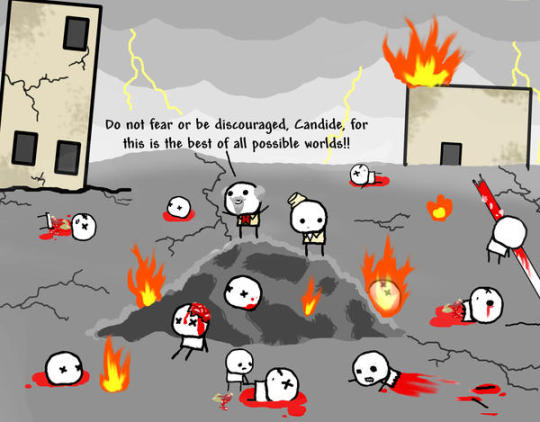
Russian lit. Again, not Henry vibe exactly, but deep enough and very insane vibes. Crime and Punishment if you want yearning, self guilt and inner struggles.

Gogol's Overcoat and The Nose if you want some Russian surrealism.
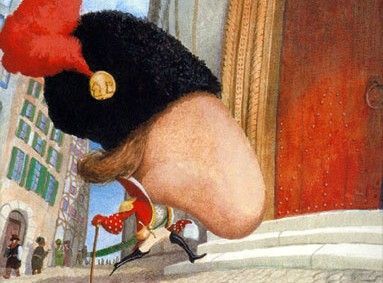
#classic lit recs#dark academia#basically a lit student#the secret history#Dostoievsky#quo vadis#seneca#marcus aurelius#caligula#niccolo machiavelli#ovid#philosophy#classics
158 notes
·
View notes
Text
" Phyllis " //© The Garden Of Bob
In Greek mythology, there was a beautiful princess named Phyllis, who lived in Thrace. Phyllis fell deeply in love with a young hero named Demophon, the son of King Theseus of Athens. Demophon visited Thrace during his travels and was captivated by Phyllis’s beauty and kindness. The two young lovers vowed to marry and spend their lives together. However, Demophon had to return to Athens, promising to return for Phyllis soon after attending to some matters in his kingdom. Days turned into weeks, and weeks into months, but Demophon did not return as promised. Phyllis waited patiently and faithfully, but as time passed, her hope waned, and her heart filled with sorrow and despair. Believing that she had been abandoned, Phyllis fell into a deep state of grief. Unable to bear the pain of her broken heart, Phyllis retreated to the woods, where she wept and prayed for relief. The gods, moved by her devotion and suffering, decided to transform her into an almond tree. As her tears watered the ground, a beautiful almond tree with delicate pink and white flowers emerged. Just as the almond tree blossomed, Demophon finally returned to Thrace, remorseful for his delay. When he learned of Phyllis’s fate and witnessed the almond tree with its exquisite flowers, he was overwhelmed with grief and guilt. Demophon embraced the almond tree, pouring his heart out in apology for not keeping his promise to Phyllis. The tree, in response to his touch and words of sorrow, miraculously burst into full bloom in the middle of winter, signifying the renewal of love and hope.
Music: © Lindsey Stirling - Crystallize
#United States#nature#landscape#Macro#Wildflowers#4K#8K#12K#fpv#reels#aesthetics#wanderlust#explore#follow#discover
78 notes
·
View notes
Text

Tetradrachm minted 364-363 BCE by the city of Amphipolis, at the mouth of the River Strymon in Thrace. On the obverse, the head of Apollo, wearing a laurel crown; on the reverse, a race torch surrounded by a square bearing the inscription AMΦ-IΠO-ΛIT-EΩN (="of the people of Amphipolis").
Formerly an Athenian colony, Amphipolis was lost to Athens during the Peloponnesian War as a result of the Spartan general Brasidas' brilliant northern campaign; an attempt by the noted demagogue Cleon to recover it ended in his defeat and death (though Brasidas was killed as well). Thereafter the polis remained independent, enjoying great strategic importance for a number of reasons: the nearby forests supplied vital timber for shipbuilding; local silver mines offered vast wealth to whoever controlled them; and the city was in a prime location to facilitate--or interfere with--grain shipments to Athens from the Black Sea region. However, only a few years after this coin was minted, the expansionist Philip II of Macedon conquered Amphipolis and consolidated his hold over Thrace. Amphipolis would remain an important Macedonian stronghold until the kingdom's defeat by Rome in 168 BCE.
Photo credit: Classical Numismatic Group, Inc. http://www.cngcoins.com
#classics#tagamemnon#Ancient Greece#ancient history#Greek history#Ancient Greek history#Classical Greece#art#art history#ancient art#Greek art#Ancient Greek art#Classical Greek art#coins#ancient coins#Greek coins#Ancient Greek coins#tetradrachm#metalwork#silver#silverwork#numismatics#ancient numismatics
98 notes
·
View notes
Text
Coin of the Day #27 (5/31/2024)
How about a nice Greek coin to close out May…


Kings of Thrace
AR Drachm - 18mm 3.98g
Lysimachos 301-281 BC
Kolophon Mint
Obverse Head of Herakles right, wearing lionskin
Reverse ΒΑΣΙΛΕΩΣ ΛΥΣΙΜΑΧΟΥ
Zeus Aëtophoros seated left, lion above crescent right, pentagram below throne
Price L28
#coin of the day#kingdom of thrace#thrace#lysimachos#ancient greece#greek coins#coin#coins#numismatics#kolophon#ancient coins
1 note
·
View note
Text

Some of my OCs!!!! (Don't think too much about the clothing, it's just there and probs not historically accurate).
Wanted to draw how they look like in my head, Dacia & Thrace & the Getae. I'll probably change some stuff later idk not truly happy with how they look
Also this is Thrace but at a time when he was younger since I think when he grows into an adult he probs grows a beard
(Notes under the cut)
they're...siblings in the weird nation way.
Thrace's hair probably darkens even more as he grows up since I see him as having darker hair as an adult dbdhhddj
The Getae & Dacia might have been the same, or might have been very strongly related but I chose the make 2 OCs for them
(And I don't really have OCs for them yet, but I do think all the tribes that made up the dacians & the thracians also had personifications)
Dacia's slight resemblance to Romania was intended haha
Might change Thrace's eye colour idk
dacia would have probably worse some kind of head scarf or had her hair tied up but I wanted to draw her with her hair down
Idk can't think of anything else to say atm
#just talking recreationally#hetalia#Dacia#Thrace#Odrysian kingdom#Getae#Aph#Hws#Hws dacia#Hws thrace#Hws getae#Ancientalia#Hetalia ancients
5 notes
·
View notes
Text
EVENT POLL: 30-WOMAN ROYAL RUMBLE FOR FICTIONAL CHARACTERS TIME! (part 5)

#fictional royal rumble#royal rumble#carol danvers#lucina#Korra#makima#eowyn#aeryn sun#ahsoka tano#rapunzel#gow freya#kathryn janeway#aqua kh#mirabel madrigal#marvel#fire emblem#the legend of korra#chainsaw man#the lord of the rings#farscape#Star Wars#tangled#god of war#star trek voyager#kingdom hearts#encanto#tumblr polls#polls#character polls#fandom polls
15 notes
·
View notes
Text
"Arsinoë (II) lived a dramatic and adventurous life, full of extreme highs and lows. In its course, she played a part in the courts of four kings, married three times (twice to a sibling or half sibling), saw two of her sons murdered, fled two kingdoms because her life was in danger, yet ended her days in great wealth and security and ultimately was deified. Born in Egypt (as the daughter of Ptolemy I Soter and Berenike), she departed as a teenage bride for marriage to Lysimachus, ruler of Thrace, parts of Asia Minor, and Macedonia. After her husband died in battle, she tried to protect the claims of her three sons to rule in Macedonia against the attempts of others to seize the kingdom. In support of this effort, she married one of these rivals (her half brother Ptolemy Ceraunus), only to have this marriage alliance end in a bloodbath that compelled her to return to Egypt, where her brother Ptolemy II had succeeded their father as king. Once back, Arsinoë married her brother (the first full brother-sister marriage of a dynasty that would make such marriages an institution). She died in Egypt, having spent her last years playing a prominent role in the kingdom. Throughout much of her life, Arsinoë controlled great wealth and exercised political influence, but domestic stability characterized only her last few years.
Bitter and sometimes violent struggles for the throne marked nearly her entire career [...] Her childhood experience coping with life in a court divided by succession politics colored virtually all the major decisions of her life. She played the roles of both victim and victimizer: Arsinoë likely had a hand in one murder but endured the slaughter of her younger sons. She possessed some political acumen and considerable drive, but boldness and the willingness to take risks were her most salient personality traits, the ones that led to her most dramatic successes and failures. Like most of the members of the Macedonian elite, male and female alike, Arsinoë single-mindedly and sometimes violently pursued kleos (fame, renown) for herself, her sons, and her dynasty."
-Elizabeth D. Carney, "Arsinoë of Egypt and Macedon: A Royal Life"
15 notes
·
View notes
Text
nabbed from the feed
Rules: Make a poll of your favorite female characters (no limits - as many or as little as you want) and see which your followers like the most!
#u#the addams family#sailor moon#pride and prejudice#stargate sg1#battlestar galactica#the immortals#tamora pierce#the old kingdom#star trek: ds9#tgcf
12 notes
·
View notes